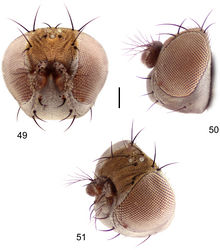Hydrochasma viridum
| Notice: | This page is derived from the original publication listed below, whose author(s) should always be credited. Further contributors may edit and improve the content of this page and, consequently, need to be credited as well (see page history). Any assessment of factual correctness requires a careful review of the original article as well as of subsequent contributions.
If you are uncertain whether your planned contribution is correct or not, we suggest that you use the associated discussion page instead of editing the page directly. This page should be cited as follows (rationale):
Citation formats to copy and paste
BibTeX: @article{Mathis2013ZooKeys363, RIS/ Endnote: TY - JOUR Wikipedia/ Citizendium: <ref name="Mathis2013ZooKeys363">{{Citation See also the citation download page at the journal. |
Ordo: Diptera
Familia: Ephydridae
Genus: Hydrochasma
Name
Hydrochasma viridum Mathis & Zatwarnicki, 2013 sp. n. – Wikispecies link – ZooBank link – Pensoft Profile
Diagnosis
This species is distinguished from other congeners by the following combination of characters: Small shore flies, body length 1.25–1.45 mm. Head: Antenna mostly blackish gray; medial surface of basal flagellomere mostly dark colored; parafacial silvery white, concolorous with facial coloration (Figs 49–51); gena-to-eye ratio 0.23–0.25. Thorax: Mesonotum with extensive metallic green coloration, extended laterally to notopleuron and presutural area. Wing with costal vein ratio 0.80–0.82; M vein ratio 0.46–0.48. Forefemur lacking a distinctive, comb-like row of stout setulae along anteroventral surface; tibiae mostly gray; hindtibia bearing a long, spur-like seta ventroapically. Abdomen: Tergites 1–4 greenish gray, subshiny, lacking wedge-shaped, gray to silvery gray areas, tergite 5 of male more gray colored than preceding tergites. Male terminalia (Figs 52–56): Combined structures generally moderately elongate, in posterior view height slightly more than 3× width, generally sparsely setulose dorsally, bearing large to small setulae ventrally; epandrium with dorsal arch above cerci relatively thinly developed, incompletely connected medially, in posterior view (Fig. 52) as an inverted U on dorsal third with disconnect dorsomedially, thereafter ventrally widest sub-basally, then tapered with lateral margins shallowly curved medially, ventral third as very thin, elongate, digitiform, parallel-sided projections, these cruciate subapically, deeply bifurcate medially, medial bifurcation wider basally than width of ventral projections at same level, ventral epandrial projections minutely setulose, apical setulae stout, apex rounded; cerci moderately long, height nearly twice width, widely semi-hemispherical (Fig. 53), not attached lateroventrally with epandrium; aedeagus in lateral view (Fig. 55) elongate, over 5× longer than wide, tubular, shallowly curved, slightly tapered toward apex with apical portion moderately and irregularly pointed, in ventral view (Fig. 54) nearly straight sided, slightly thinner medially than basally or subapically, apical portion tapered to narrowly rounded apex; phallapodeme in lateral view (Fig. 55) generally narrow to very shallowly and broadly triangular, extended keel only a slight bump toward attachment with hypandrium, in ventral view (Fig. 54) an elongate, thin T with crossbar very short; gonite in lateral view (Fig. 55) narrow, elongate, bar-like, very shallowly curved, in ventral view (Fig. 54) shallowly curved, tapered at both ends; hypandrium in lateral view (Fig. 55) elongate, as long or slightly longer than aedeagus, moderately thin, mostly parallel sided, anterior portion evenly tapered to narrowly rounded anterior apex, in ventral view (Fig. 54) generally as a gently curved arrowhead with posterior half generally narrower, posterior margin widely and moderately deeply emarginate with narrow, lateral arms, tapered to anterior portion of base, anterior portion elongate, V-shaped with lateral margins shallowly curved, with elongate, narrow, lateral, posterior extended processes that are aligned parallel to overall orientation of hypandrium, anterior margin tapered to bluntly rounded apex.
Type material
The holotype male of Hydrochasma viridum is labeled “GUYANA. Karanambo[,] Rupununi Riv[er],ox bow[,] 3°45.1'N, 59°18.6'W[,] 2Apr1994, W. Mathis/HOLOTYPE ♂ Hydrochasma viridum Mathis & Zatwarnicki, USNM [red]/USNM ENT 00089395 [plastic bar code label].” The holotype is double mounted (minuten in a block of plastic), is in good condition (some dirt specks on specimen), and is deposited in the USNM. Paratype are as follows: GUYANA. Moco-Moco, Lethem (30 km E in Kanuku Mountains; 03°18.2'N, 59°39.0'W), 3–6 Apr 1994, W. N. Mathis (1♂, 1♀; USNM); Pirara Ranch and River (03°32.1'N, 59°40.5'W), 24–25 Apr 1995, W. N. Mathis (1♂, 1♀; USNM).
Type locality
Guyana. Karanambo, Rupununi River (ox bow; 03°45.1'N, 59°18.6'W).
Distribution
(Fig. 56). Neotropical: Guyana.
Etymology
The species epithet, viridum, is of Latin derivation, meaning green, and refers to the metallic green coloration of the mesonotum.
Remarks
Externally, the dorsum of the head and mesonotum of this species is unique among congeners, especially species in the faciale group, in having a pronounced, subshiny to shiny, with mostly greenish to bluish luster. Internally, this species could only be confused with Hydrochasma patens, and indeed, structures of the male terminalia of these two species are similar, although differing in details (compare Figs 26–29 with Figs 52–55).
Original Description
- Mathis, W; Zatwarnicki, T; 2013: A revision of the shore-fly genus Hydrochasma Hendel (Diptera, Ephydridae) ZooKeys, 363: 1-161. doi
Images
|
![Figures 26–29. Hydrochasma patens Cresson (Chile. Talca: Rio Lircay, 11 km N Talca) 26 epandrium and cerci, posterior view 27 same, lateral view 28 internal structures of male terminalia (aedeagus [shaded], phallapodeme, gonite, hypandrium), ventral view 29 same, lateral view. Scale bar = 0.1 mm.](https://species-id.net/o/thumb.php?f=ZooKeys-363-001-g011.jpg&width=171)

![Figures 52–55. Hydrochasma viridum sp. n. (Guyana. Pirara Ranch and River) 52 epandrium and cerci, posterior view 53 same, lateral view 54 internal structures of male terminalia (aedeagus [shaded], phallapodeme, gonite, hypandrium), ventral view 55 same, lateral view. Scale bar = 0.1 mm.](https://species-id.net/o/thumb.php?f=ZooKeys-363-001-g021.jpg&width=167)
